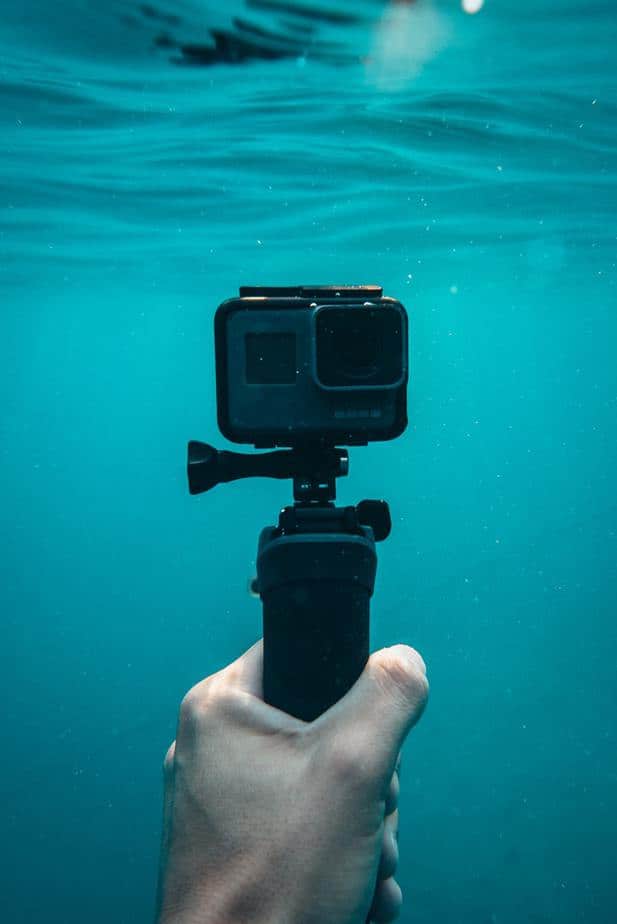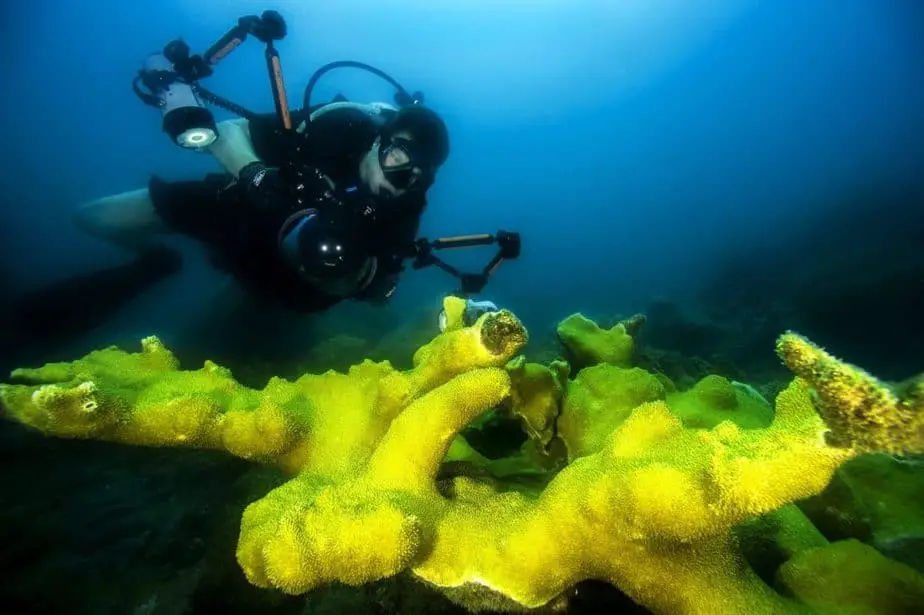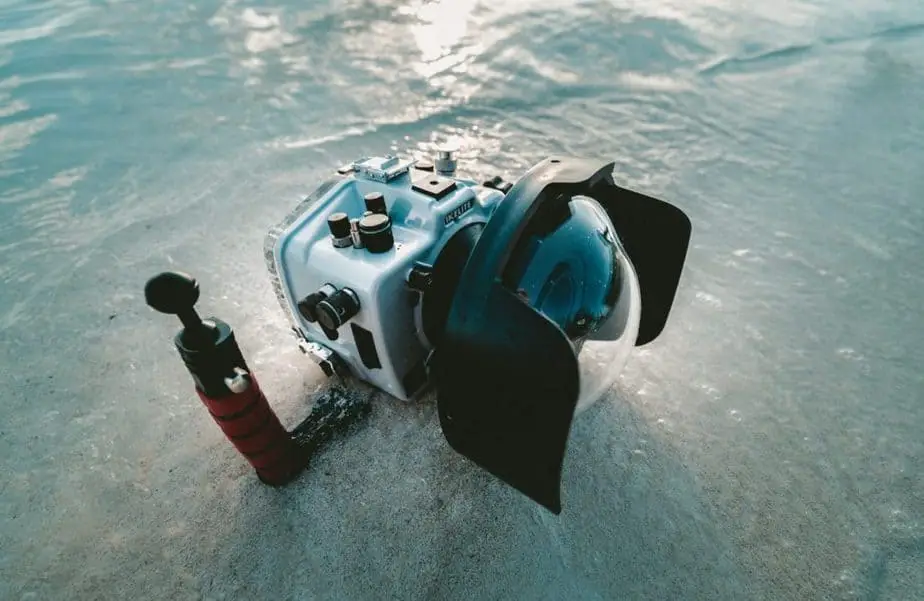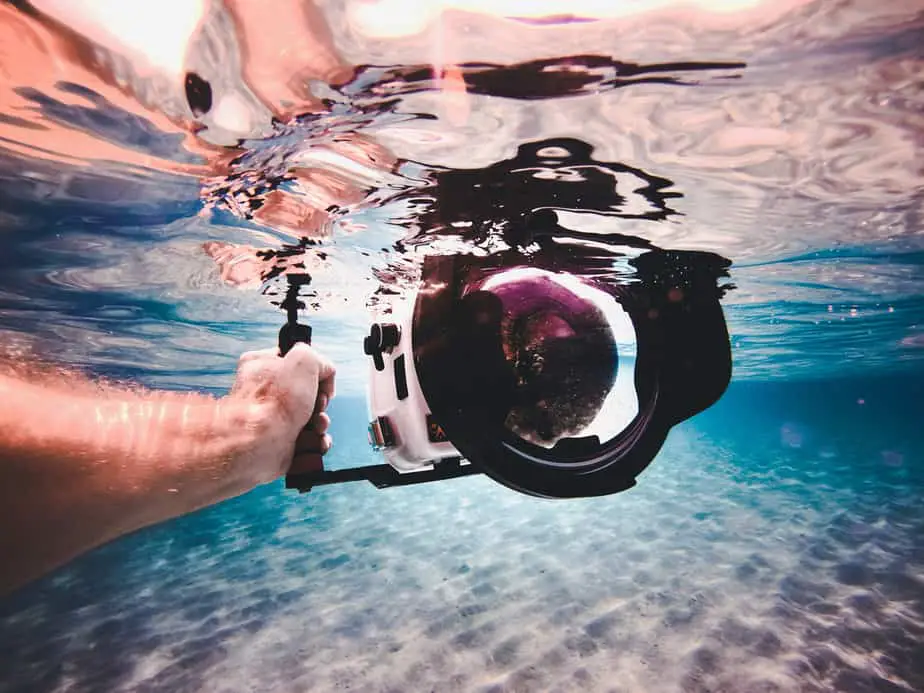When you first bought your underwater camera, after the initial excitement wore off you were probably left scratching your head wondering how you are supposed to carry a camera while snorkeling. I was in the same boat when I got my first GoPro.
I googled and looked online to find that most people recommended using a head strap. Upon further research, it turned out to be one of the least effective options to carry a camera underwater if you actually want good footage.
So it was back to the drawing board, and I started trying out different options to varying degrees of success. In this article I will be going over my thoughts on the different ways I’ve tried carrying a camera for snorkeling over the years.
Personally, I prefer to mount the camera on a pole or wrist strap when I am snorkeling. You could also mount it to a catch bag or just hold it by hand and get satisfactory quality footage.
Some additional options are to mount a camera to your snorkel mask, scuba tank, or on a head strap. These are options that I do NOT recommend. The footage you capture will be shaky, disorienting, or exhaust bubbles will get in the way. You also run the risk of losing your camera since it’s not in your hands. Let’s go over each option in greater detail below.
#1. Camera on a Snorkel Mask or Head Strap
This is the most commonly recommended option when it comes to camera mounts and that is to mount it on your head using a head strap or attach it directly to the snorkel mask. So let’s talk about this first as well.
If this is your preferred option, keep in mind that you need to hold onto the camera as you enter the water, otherwise it is very easy for the camera to get knocked off your head. For additional support, I recommend using line yarn to secure the camera more tightly.
Advantages
There aren’t that many advantages. At least after you enter the water, if all goes well, it is a hands off experience and you can snorkel without holding the camera.
Disadvantages
With this approach, the chances are high that you will get extremely shaky footage. Even if you try your best to keep your head stable and do a smooth panning shot, it’s not going to be as smooth as you think. You are trading off stable footage for ease of use.
Furthermore, there is always the risk that the camera will fall off the head strap or snorkel mask. If the head strap is not tight enough, dropping your very expensive camera will quickly make you reconsider this method. Also, if it is mounted to your snorkel mask, the weight of the camera may break the seal, causing a water leak.
Overall
The shots you get from a camera mounted to your head is placed in an awkward position on your head, which restricts your movements while snorkeling. Furthermore, the footage will be shaky because of the poor stability of a head strap. This is probably one of the worst ways you could carry your camera while snorkeling or diving and I don’t recommend it.

#2. Camera Pole or Wrist Strap
It’s really easy to carry and mount a camera on a camera poll. This setup is great for taking selfies, making it relatively popular for snorkelers and divers who wish to capture themselves in their photos.
Advantages
Camera poles and wrist straps are easy to use and there are few issues since you are holding the poll at all times. The quality of the shots you can get with a camera pole are excellent, owing to the stability that the pole provides compared to a head strap. Furthermore, the more you use the pole, the better you will get at stabilizing it.
Disadvantages
The first few times using it you will probably have trouble taking stable and smooth shots.
Overall
Camera poles are affordable and provide an easy way for you to capture high quality, stable footage underwater. They are worth trying out. You can get comparable results by mounting the camera on a sturdy wrist strap. Using either a camera pole or wrist strap is probably one of the simplest and most affordable methods currently.
#3. Hand Held Camera
If you’re not a fan of mounting the camera somewhere out of your hands, you could always just carry it by hand. With that said, you should still use a mount and an extension arm to make a handle for you to hold the camera. Carrying and using the camera with your hands is probably the most flexible and easiest way to shoot footage or take nice pictures.
Advantages
You have the most control when the camera is in your hands. Even when you use a pole, you are sacrificing a degree of control compared to a hand held camera. Furthermore, you can easily hang onto it and snagging on things should not be an issue. Since you can quickly point the camera wherever you want, it’s a lot easier to get good photos with your subject matter in focus compared to using a camera pole for instance.
Disadvantages
The main downside of holding the camera by hand is how shaky it is since you have no other methods of stabilizing it. Thus, your photos or footage may pick up some handling noise. With practice you could improve your stability, however it will cause you to use a lot of energy to keep the camera completely level and steady underwater for a smooth shot.
Overall
All things considered, carrying the camera by hand is an easy option for you to just point and shoot. The performance is fair, and with practice you can get more stable shots. You can improve your performance if you mount the camera to a catch bag and use it as a fig rig camera stabilizer.

#4. Camera on A Scuba Tank or Over Your Shoulder
(Note: This doesn’t apply to snorkelers, however for the sake of completeness we’re going to cover this option as well. Similar options for snorkelers are discussed below.)
There are many mount banded hardware you can use to attach the camera with using only a few screws, some wing nuts, and a pipe clamp. Once you’ve secured the clamp nuts around the neck of the scuba tank, you can then attach an extension arm and a GoPro mount adaptor to it. The end result is a mounted camera hanging over your shoulder that is connected to the tank.
Advantages
With the camera mounted above the head, you can get an excellent over the shoulder surface view of the diver and the environment. The footage captured will provide a reasonably close view of what the diver is seeing, kind of like you’re viewing it from a first person perspective. Since it is not mounted on the mask, it won’t be as shaky while providing a similar angle.
Snagging is not much of an issue unless you extend the rig further away from your head. The chances of snagging on something increases the longer it is. You probably don’t want to use a diving rig either. Once you’ve got the extension arm installed and the camera mounted, the rig will remain relatively level and stable.
Disadvantages
With that said, mounting the camera to the scuba tank has some major issues that become apparent once you start diving down. That is, the exhaust bubbles often get in the way. You will not realize how much of a problem it is along the surface. However, in some positions while deep underwater, the exhaust bubbles will completely obstruct the camera.
The ease of use is pretty poor as soon as you need to reach for the camera for any reason. Furthermore, if the camera gets shifted out of position, chances are you won’t even notice.
Overall
Overall I’d say mounting the camera to the scuba tank is not a good idea. Air bubbles will constantly get in the way and ruin your footage. If you want to get the camera further away to avoid this, you’ll need a double joiner and an additional arm from the mount band. This just adds more bulk to your rig and increases the chance of snagging.
Furthermore, the camera position can still be knocked out of position, such as when you exit the boat into the water. When the camera is further back it is not too hard to grab and adjust it, but you will still have to guess how the footage is being framed.
#5. Camera Mounted to Catch Bag
By using a bow mount, you can easily fasten a camera to the handle of a catch bag.
Advantages
As you’re exploring and trying to find the next shot, you can just leave the camera mounted to the catch bag for easy access. Another advantage is that the catch bag handles can be used as stabilizers thanks to the two hand grip it offers for a more stable shot.
Furthermore, connecting the camera to the catch bag is very easy, requiring just a few twists of the screw. Another option is to hold the camera using a pistol grip while the catch bag is connected. This setup is also easy to use and relatively hassle and snag-free.
Disadvantages
There are not many disadvantages here.
Overall
Thanks to the flexibility that this option provides, rivaling even a hand held camera, you can get excellent shot quality. However, by providing extra grip to stabilize the camera, you can get shots that are not just stable and smooth but also with less noise compared to handheld. Furthermore, you can basically set and forget the camera is once it’s been attached to the catch bag.

#6. Camera on Chest Harness or Strap
Last but not least we have a simple mount that can be done on the strap or harness on your chest. There are numerous options that allow you to mount a camera to the straps of your vest.
Advantages
The way the camera is mounted in the other options, when you roll out of a boat and hit the water the camera is frequently knocked out of position and it can be difficult to adjust. This isn’t an issue with a camera mounted on a chest strap or harness because of how easily accessible it is by your chest. The camera will also be out of your way and won’t cause any issues as you film.
Disadvantages
With that said, compared to the other options having a camera mounted to a chest strap is not the most secure choice. You will find that the camera sometimes gets yanked out of position, however this downside is somewhat mitigated by how easy it is to set it back in position. Some people will find this annoying, however.
Furthermore, if you are scuba diving, then the scuba hose may sometimes get in the frame. Also, the closer the camera is to the diver, the more likely it is to capture the exhaust bubbles; not just in the frame, but also the noise it makes. The bubbles can even push the camera out of place, and having the camera at chest height may make it difficult to see what’s going on compared to head height or over the shoulder. Lastly, you won’t be able to get surface level shots.
Overall
If it isn’t obvious by how large the Disadvantages section is, mounting the camera on a chest harness is not a very good option. The overall result is a poor view of the bigger picture, a camera that constantly gets buffeted by air bubbles, causing vibrations and noise and lowering the quality of the footage.
To try to avoid this, you could mount the camera further sideways on the left or right side to keep it away from the bubbles. Just make sure not to mount it on a pull cord. By setting it up like this, you can get better usability, however the shot will still not be wide enough. Furthermore, sometimes bubbles can still reach the camera.
In an attempt to prevent the camera from getting knocked out of place when exiting the boat, you can mount the camera upside down facing your chest. By doing this, you can keep the camera tucked between your chest and arm, lowering the impact. Lastly, because of how low the camera is mounted, even when you surface the water the camera will still be underwater, meaning no surface shots.
What is the Best Way to Carry Camera While Snorkeling?
Having tried out the options above, I prefer either carrying the camera either by hand, mounted on a catch bag, or else mounted on a pole for those nice selfie shots. I am primarily a snorkeler and I don’t like to carry around a bunch of gear, so for me the simplest options are the best ones.
If you plan on going with the handheld camera approach, then I recommend you check out my article on how to take pictures while snorkeling.
For those who prefer a hands-free approach, the cheapest option is to mount it on a head strap or on a chest strap. However, there are many disadvantages to this, such as how unstable and low-quality the footage can get.
Mounting the camera on the scuba tank requires a lot of work and technical know-how, and personally we think that it’s not worth the effort. If you know of more methods to carry the camera while snorkeling, or you just want to share your carrying methods, then let us know below.

